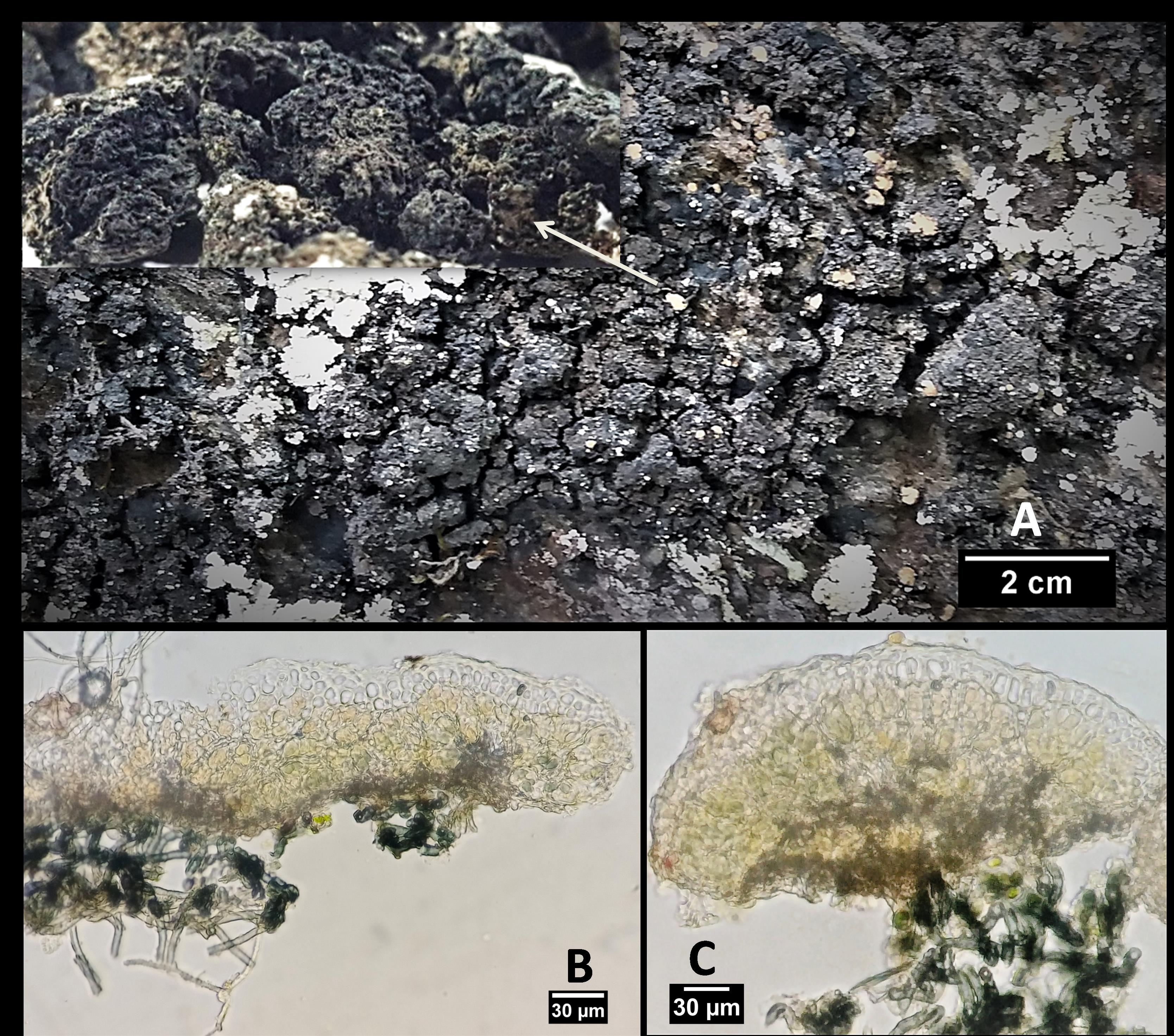First Report of Genus Parmeliella Müll. (Peltigerales; Lecanoromycetes; Ascomycota) from Pakistan
DOI:
https://doi.org/10.33411/ijist/2022040215Abstract
When studying lichens in Pakistan, we came across a crustose species with small to moderate squamulose on a thin blackish hypothallus with a dry, rough, gray-brown to the black upper surface. The standard chemical tests integrated with conventional to modern taxonomic tools were used to name the specimen. Consequently, with minor differences in the morphology, and no difference in nucleotides, the lichen species was baptized Parmeliella thriptophylla (Ach.) Müll. Arg. The descriptive taxonomy and n-ITS-based phylogeny of this species with its habitus are presented in this study. No previous record of this species, genus, or family was found in Pakistan.
References
P. M. Jørgensen, “NEW OR INTERESTING PARMELIELLA SPECIES FROM THE ANDES AND CENTRAL AMERICA,” Lichenol., vol. 32, no. 2, pp. 139–147, Mar. 2000, doi: 10.1006/LICH.1999.0259.
P. M. Jørgensen, “Notes on Some Misunderstood, Subtropical Parmeliella Species on JSTOR,” Bryologist, vol. 106, no. 1, pp. 121–129, 2003.
S. Ekman, M. Wedin, L. Lindblom, and P. M. Jorgensen, “Extended phylogeny and a revised generic classification of the Pannariaceae (Peltigerales, Ascomycota),” Lichenol., vol. 46, no. 5, pp. 627–656, 2014, doi: 10.1017/S002428291400019X.
P. F. Cannon and P. F. Kirk, “Fungal families of the world,” Fungal Fam. world, 2007, doi: 10.1079/9780851998275.0000.
E. Wiklund and M. Wedin, “The phylogenetic relationships of the cyanobacterial lichens in the Lecanorales suborder Peltigerineae,” Cladistics, vol. 19, no. 5, pp. 419–431, 2003, doi: 10.1111/j.1096-0031.2003.tb00312.x.
B. P. Lofall, “Stiftfiltlav Parmeliella triptophylla i Østfold,” Natur i Østfold, INNHOLD, pp. 136–138, 1995.
T. D. BRUNS and M. GARDES, “Molecular tools for the identification of ectomycorrhizal fungi--taxon-specific oligonucleotide probes for suilloid fungi,” Mol. Ecol., vol. 2, no. 4, pp. 233–242, 1993, doi: 10.1111/J.1365-294X.1993.TB00013.X.
S. Ekman and P. M. Jørgensen, “Towards a molecular phylogeny for the lichen family Pannariaceae (Lecanorales, Ascomycota),” Can. J. Bot., vol. 80, no. 6, pp. 625–634, 2002, doi: 10.1139/B02-043.
M. Khan, A. N. Khalid, and H. Thorsten Lumbsch, “A new species of Lecidea (Lecanorales, Ascomycota) from Pakistan,” MycoKeys, vol. 38, no. 38, p. 25, Aug. 2018, doi: 10.3897/MYCOKEYS.38.26960.
J. Hafellner, “Towards a better circumscription of the Acarosporaceae ( lichenized CryptogamicBotany,” no. January 1995, 2016.
M. E. Hale, “How to know the lichens,” p. 226, 1969.
“BIOEDIT: A USER-FRIENDLY BIOLOGICAL SEQUENCE ALIGNMENT EDITOR AND ANALYSIS PROGRAM FOR WINDOWS 95/98/ NT | Semantic Scholar.” .
D. L. Hawksworth, “The Lichen Family Pannariaceae in Europe. By Per M. Jørgensen. [Opera Botanica No. 45.] Swedish Natural Science Research Council, Stockholm. 20 November 1978. Pp. 123, figures 53, tables 8. Price SKr 110 (SKr 66 for personal use).,” Lichenol., vol. 11, no. 2, pp. 204–204, Jun. 1979, doi: 10.1017/S0024282979000244.
P. M. Jørgensen, “New or Interesting Parmeliella species from the andes and central America,” Lichenol., vol. 32, no. 2, pp. 139–147, 2000, doi: 10.1006/LICH.1999.0259.
K. Habib and A. N. Khalid, “New records of lichens from the State of Azad Jammu and Kashmir, Pakistan corroborated by ITS sequences,” Nov. Hedwigia, vol. 109, no. 3–4, pp. 457–473, 2019, doi: 10.1127/nova_hedwigia/2019/0552.
T. H. I. Nash, B. D. Ryan, P. Diederich, C. Gries, and F. Bungartz, “Lichen flora of the greater Sonoran Desert region, vol. 1,” vol. 1, 2002, Accessed: May 12, 2022. [Online]. Available: https://heritage.nv.gov/documents/lichen-flora-of-the-greater-sonoran-desert-region-vol-1.
T. H. Nash, Lichen flora of the greater Sonoran Desert region. Tempe Ariz.: Lichens Unlimited Arizona State University, 2002.
G. Urbanavichus and A. Ismailov, “New records of lichens and lichenicolous fungi from Dagestan, Russia,” Folia Cryptogam. Est., vol. 53, no. January, pp. 65–69, 2016, doi: 10.12697/fce.2016.53.08.
S. Rashmi and H. G. Rajkumar, “Diversity of Lichens along Elevational Gradients in Forest Ranges of Chamarajanagar District, Karnataka State,” Int. J. Sci. Res. Biol. Sci., vol. 6, no. 1, pp. 97–104, Feb. 2019, doi: 10.26438/IJSRBS/V6I1.97104.

Published
How to Cite
Issue
Section
License
Copyright (c) 2022 50sea

This work is licensed under a Creative Commons Attribution 4.0 International License.




















